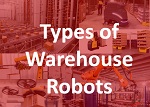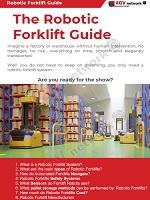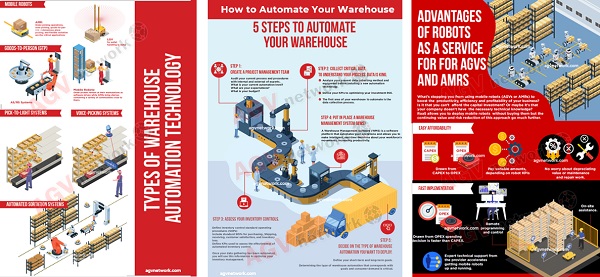16 Amazing Warehouse Robots Transforming Logistics Operations
 I'm pleased to take you on a journey into the world of warehouse robotics and show the how automated warehouse robots are altering the logistics sector.
I'm pleased to take you on a journey into the world of warehouse robotics and show the how automated warehouse robots are altering the logistics sector.
These robots are changing the way warehouses and distribution centers function, from autonomous cleaning robots to robotic forklifts.
In this post, I'll go over 16 different types of warehouse robots, how they're employed, and I will show you some videos of warehouse robots at work.
 My name is Alfredo Pastor and I love ❤ helping companies to automate and improve their material handling operations.
My name is Alfredo Pastor and I love ❤ helping companies to automate and improve their material handling operations.
Whether you're a warehouse manager wanting to improve your operations or simply curious about the latest technologies, this article will give you with helpful insights and information about warehouse robotics solutions.
So let's get started and investigate the world of automated warehouse robots!
What are the main types of warehouse robotics?
These are the most common robots used in warehouses and distribution centers:
- Automated Guided Vehicles (AGVs)
- Autonomous Mobile Robots (AMRs)
- Palletizers
- Depalletizing Robots
- Conveyor Systems
- Automated Storage and Retrieval Systems (AS/RS)
- Sorting Robots
- Packing Robots
- Pick and Place Robots
- Inventory Robots
- Cleaning Robots
- Security Robots
- Drones
- Automated Labeling Robots
- Case Erectors
- Automated Stretch Wrappers
Automated Guided Vehicles (AGVs)
Nowadays, we can find many AGVs in warehouses. For example, AGV forklifts are some of the most effective and inovative solutions for increasing productivity and improving safety in warehouses requiring pallet handling activities.
Self-driving forklifts can manage different types of material handling solutions: Racking, Drive in, Gravity, Block Stacking, etc.
Do you wish to know more about robotic forklifts? This 👇 is your guide.

What is the best? It's free... ????
| Download The AGV Forklift Guide |
Autonomous Mobile Robots (AMRs)
Autonomous self-navigating robots can move around a warehouse, pick up and move objects, and perform other tasks.

AMR Robots aim to enhance pickers' efficiency and productivity by replacing traditional fulfilment solutions that required tons of wasted time.
Autonomous Mobile Robots in warehouses are mainly utilized in order picking, zone picking, goods-to-person, autonomous piece picking, and flexible sortation activities.
The target is clear, move material to operators rather than having humans walking infinite corridors looking for an item.
Before going ahead... I guess you're interested in warehouse automation... otherwise, you shouldn't be reading this now ... great! do not miss my 54 pages free guide...

agvnetwork's free guide with useful info and illustrations
| Download The Warehouse Automation Guide |
Palletizer Robots
Palletizer robots use advanced end-of-arm tooling (EoAT) to pick up items and position them on pallets in the correct pattern, decreasing the need for manual labor and enhancing efficiency.
These robots are also capable of handling various product categories at once, making them perfect for mixed product palletizing.
One of the primary benefits of palletizer robots is their adaptability. They are easily adaptable to changes in product lines or pallet designs, which reduces the need for costly retooling.
They may also be combined with other automation technologies, like as conveyors and automated storage systems, to form a fully automated warehouse or distribution center.
Palletizer robots may continually learn and enhance their performance using the latest breakthroughs in artificial intelligence and machine learning, enhancing accuracy and efficiency over time.
Depalletizing Robots
Robotic depalletizing has completely changed how pallets are unloaded in technologically advanced warehouses and distribution centers.
These technologies provide rapid, efficient, and precise pallet unloading, improving productivity and lowering labor expenses.
Robotic depalletizers are capable of handling a wide range of pallet unloading applications, such as single-case depalletizing, row depalletizing, full-layer depalletizing, and mixed product handling.
As a result, they are well-suited to a variety of industries, including e-commerce, food and beverage, and distribution operations.
These technologies, which use powerful machine vision and artificial intelligence, can pick and put items reliably and safely, even in mixed product handling circumstances. They are also extremely adaptable, quickly adjusting to new product lines and procedures.
These technologies, with their speed, precision, and adaptability, assist warehouses and distribution centers in streamlining operations, lowering labor costs, and increasing productivity.
Conveyor Systems
Conveyors are an important part of contemporary warehouses and distribution centers because they provide a quick and effective means to transfer items and materials from one area to another.
They are often used for material handling, sorting, and order fulfillment and are an important tool for warehouse managers wanting to enhance productivity and save labor costs.
Conveyors make warehouse operations more efficient by transferring items and materials from reception to storage or from storage to the shipping area.
They can also be outfitted with sensors or other technology that allow them to sort items based on various qualities, reducing the need for manual labor and enhancing accuracy.
Conveyors may also deliver items to pick and pack stations, allowing for speedy and precise order fulfillment while lowering order processing delays and mistakes.
Automated Storage and Retrieval Systems (AS/RS)
An AS/RS or automated storage and retrieval system utilizes software, computers, and robots to automate warehouse handling, storage, and retrieval.
They're adaptable and might be small, but they can also evolve into a sophisticated automation network that can be controlled by a suitable software solution.
ASRS automates the retrieval and deposition of high-volume loads by leveraging the synergy of many distinct technologies and vehicles.
Furthermore, they do it precisely whether the load is to be placed into a storage container or removed from it and transported somewhere.
ASRS system technologies include unit-load and mini-load AS/RS, as well as horizontal and vertical carousels. The technologies utilized in an ASRS system, of which there are numerous, determine its kind.
Sorting Robots
Sorting things precisely and effectively is more important than ever in today's fast-paced and ever-changing warehousing sector.
These high-tech systems can combine robotics, conveyors, carousels, and vision-guided technologies, opening up unlimited options for optimizing warehouse operations and increasing efficiency.
With so many alternatives, it's no surprise that warehouses, distribution centers, and logistics facilities utilize a wide range of sortation methods to satisfy their individual requirements.
Several sorting procedures can be employed for optimal efficiency depending on the facility type and placement in the process flow.
Each facility will have its own set of requirements and expectations, from distribution and cross-docking to returns logistics.
Packing Robots
Packing robots are used in warehouses and distribution centers to automate the process of packaging items into containers such as boxes, bags, or envelopes. They have a wide range of uses, including e-commerce order fulfillment, retail packing, and shipping.
Packing robots often pick and place products into containers using robotic arms or other automated systems.
To optimize the packing process, packing robots can employ a range of technologies such as computer vision, sensors, and machine learning algorithms able to determine the size and form of goods and optimize packing layouts for optimal efficiency.
Packaging robots can also interface with warehouse management software and other technologies to fully automate the packing process from beginning to end.
The cartesian robot, which employs a three-axis system to operate a robotic arm in a linear motion, is one of the most common forms of packing robots. Cartesian robots are useful for packaging activities requiring precision and repeated movement.
The delta robot is another form of packing robot that employs a set of parallel arms to choose and arrange objects into containers. Delta robots are suited for high-speed packaging processes requiring quick and precise motions.
Pick and Place Robots
These robots are frequently outfitted with sensors and vision systems in order to move goods from or to a moving conveyor belt.
Pick and place robots are packaging utilities that pick items and position them in a packaging container. Items can also be selected from a conveyor belt and loaded into a packing container.
Pick and place robots can pick up a specific item from a container in bin picking applications. These pick and place robots feature superior vision systems that allow them to properly recognize the needed item, which is necessary for bin picking.
Part sorting robots can sort various things depending on their shape or information supplied about the object. They can be used to separate packages or for other similar purposes.
Inventory Robots
Warehouse and distribution facilities can benefit greatly from the employment of inventory robots, which were developed to automate the arduous task of inventory management.
Products can be identified using barcode scanning or other sensors, and stock levels can be monitored in real time.
Cycle counting, order selecting, and restocking are just some of the many uses for inventory robots.
Cleaning Robots
Cleaning robots can help keep warehouses cleaner and safer for employees by eliminating germs and other impurities that could cause disease.
Autonomous cleaning robots have numerous advantages over human cleaning machines: they are more productive since they don't require breaks, they can be set up to take the shortest possible path around an area to clean it, and they always do a thorough job.
Many varieties of cleaning robots are often used in warehouses, including:
- Floor Scrubbing Robots
- Vacuuming Robots
- Window Cleaning Robots
- Gutter Cleaning Robots
- UV-C Disinfection Robots
Security Robots
To enhance safety and security, mobile security robots are increasingly being implemented in warehouses.
A variety of sensors, cameras, and other technologies allow these robots to travel freely throughout the warehouse, keeping an eye out for intruders, illegal entry, and harmful circumstances.

The Mobile Security Robot may either follow a predefined course through the warehouse or be operated by a security guard from a remote location.
The robot's sensors and cameras allow it to monitor its surroundings and report any suspicious behavior to security staff. Moreover, the robot may be instructed to carry out standard safety checks, such as checking that all exits are unblocked and that all machinery is being operated correctly.
Mobile security robots have the potential to enhance warehouse security and safety while also lowering the requirement for human security guards to do round-the-clock patrols.
Drones
Unmanned aerial vehicles (UAVs), or drones, have several applications in warehouses.
Some uses for drones in storage facilities include the following:
- Drones equipped with cameras or sensors may be flown above warehouse shelves to take pictures of the items there. These pictures can then be processed by software to stay updated on stock levels.
- Drones with cameras or sensors can scan the ceiling, roof, or upper shelves of a warehouse for signs of wear and tear or other maintenance concerns.
- Drones can be used for order picking, which entails retrieving items from one area and delivering them to another, such as from a warehouse shelf to a packaging station.
- Drones can keep an eye on the warehouse's perimeter and report back if they see any suspicious activity.

Click here to download the free Warehouse Drones infographic
Automated Labeling Robots
Warehouses and distribution hubs utilize Automatic Labeling Robots to label items. Sensors and cameras help the robot place the label in the right spot on the product or packaging.
The Automatic Labeling Robot picks labels from a stack or reel and labels the product or package. The robot applies the label using a vacuum or adhesive depending on the label and product.
Case Erectors
At warehouses and packing facilities, case erectors mechanically build cardboard boxes and cases from flat, folded cardboard.
The case erector takes flat cardboard and folds and glues it to make a box. A filling station packs things into the box once it is created.
A case erector speeds up box assembly compared to folding and gluing, saving time and money.
Automated Stretch Wrappers
Robots known as "Automated Stretch Wrappers" are commonly seen at distribution centers and warehouses, where they are employed to wrap pallets of items in stretch film to keep them safe while in transit or storage.
The pallet is placed on a turntable, and the Automatic Stretch Wrapper does the rest.
The pallet is then mechanically wrapped with stretch film by an arm that rotates up and down and around the pallet. When the film is severed, the pallet may be removed from the lift and put into storage or transportation.
By wrapping pallets more rapidly and uniformly than human operators, Automatic Stretch Wrappers lessen the possibility of personal injury to workers and product damage.
Stretch film may be applied more uniformly and tightly, safeguarding products during transit and storage.
Conclusions
Finally, the world of warehouse robotics is continuously growing, and these 16 different sorts of robots are only the tip of the iceberg.
The potential for robots to alter the logistics business is limitless, thanks to recent developments in AI, machine learning, and other technologies.
These robots improve productivity, accuracy, and safety in warehouses and distribution centers throughout the world by automating repetitive and labor-intensive operations.
Looking ahead, it's evident that the importance of robots in warehousing will only expand, and I can't wait to see what advancements come next.
|
Related articles |
 Written by Alfredo Pastor Tella (agvnetwork editor).
Written by Alfredo Pastor Tella (agvnetwork editor).
Follow me on LinkedIn... let's create a mobile robot community to discuss and learn about these outstanding systems.



